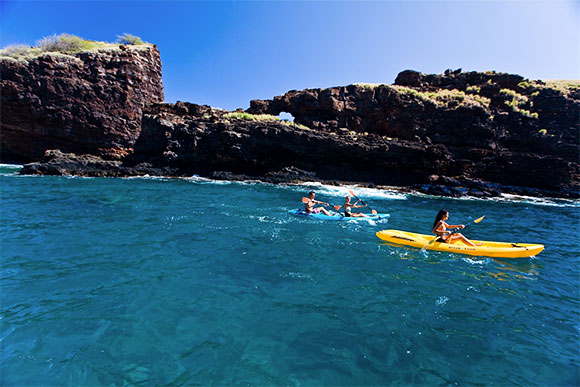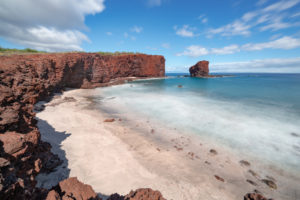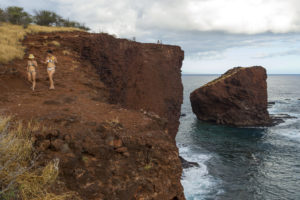
The “Most Secluded Island” offers adventure and romance
If you’re looking for nightlife, Lanai may not be your best choice. Alternately known as Hawaii’s “Most Secluded Island” and “The Pineapple Island” (it once hosted the world’s largest pineapple plantation), Lanai is home to a mere 5,000 residents — the vast majority of whom live in the cool heights of Lanai City overlooking the vast, red-dirt fields below.
What Lanai lacks in discos it more than makes up for in outdoor adventure. Not far from Lanai City you’ll find the Munro Trail, which climbs from the city’s 1,600-foot elevation through stands of Norfolk pines (planted in the early 1900s by New Zealand naturalist George Munro) and up to the highest point on the island, Lanaihale (“house of Lanai”). From this point at 3,370 feet five other islands are visible on a clear day, along with much of Lanai — including Maunalei Gulch, where the island’s defenders were unable to stop the advance of Kamehameha I’s warriors in his quest to unite the Hawaiian Islands in the late 18th and early 19th centuries.
Points of Interest
Back on the coast visitors have a number of options, though many require either a four-wheel-drive vehicle or a good set of hiking shoes. In Kaunolu Village, a national historic landmark on the south side of the island, some of the best-preserved ruins and petroglyph carvings from ancient Hawaii are found. To the southeast are the abandoned fishing villages of Lopa, Naha and Keomuku, all of which are rumored to be guarded by the mana (spiritual power) of former residents. (It is said that if you climb the coconut trees here without first saying the proper prayers, you will not come back down.)
On the eastern shore, Shipwreck Beach is a haven for beachcombers and a testament to the island’s reputation as an unsafe harbor in a storm. Named for the remains of a World War II liberty ship rusting offshore, this eight-mile strand captures everything from Nautilus shells to timbers and assorted ocean-going debris. While the waters around Shipwreck are generally too rough to swim safely, the south-easterly shore facing Hulopoʻe Bay offers crystal-clear waters and some of the best snorkeling in Hawaii.
Although agriculture and ranching are still a vital part of Lanai’s economy, the island is these days better known as an upscale tourist destination, offering two five-star resorts — the Manele Bay Hotel and The Lodge at Koʻele.
What’s More…
- Lanai was formed about 1.5 million years ago by the volcano Palawai. The island is currently 140 square miles in size.
- Southeast Lanai’s Kaunolu Point is said to be the birthplace of the modern sport of cliff diving, begun by Hawaiian warriors leaping into the ocean from an 80-foot ledge as proof of their courage. Each August, the Cliff Diving World Championships are held at this same spot.
- The Lodge at Koʻele hosts a “visiting artists” program throughout the year, with a varying schedule of lectures and performances by world-renowned musicians, artists, chefs and more.
- Lanai’s official flower is the kaunaʻoa (yellow and orange air plant)
- The island’s official color is orange







